Following the 1986 annual meeting of the Association of Professional Sleep Societies (Columbus, Ohio, U.S.A., June 15–22, 1986), a committee of scientists was formed to review recent reports and related information on the role of human sleep and brain clocks (time-of-day variation in physiology and alertness) in the occurrence of medical and human error catastrophes. This is a report of the committee's findings and recommendations.
The committee evaluated scientific and technical reports on the distribution throughout the 24-h day of medical incidents (such as heart attack and stroke) and performance failures (such as vehicular accidents and human errors in industrial and technical operations that can affect public safety). We found that these events occur most often at times of day coincident with the temporal pattern of brain processes associated with sleep. It thus appears that the occurrence of a wide range of catastrophic phenomena are influenced by sleep-related processes in ways heretofore not fully appreciated.
The committee recognizes that there are now some efforts to assess the influence of sleep-related processes on performance in key sectors of our society. For example, the United States military participated in the NATO seminar entitled “Sleep And Its Applications for the Military” (Lyon, France, March 16–17, 1987). An obvious and major concern in connection with military applications is the possibility of human error in performance or judgment when dealing round-the-clock with allied and adversarial personnel and weapons systems located in many time zones all over the earth.
The committee recommends an increase in the number and scope of such exercises to develop awareness in both the public and private sectors of the vulnerability of humans to suffer catastrophes as a function of these processes. We also recommend the development of policies within appropriate government agencies to facilitate the study of these processes, the application of measurements to identify sleep-related risks in the workplace, and the adoption of countermeasures to minimize their detrimental influence on human welfare and public safety.
Findings
Sleep
In the past 15 years, the growth of research on sleep and the biological clocks that control it has led to significant discoveries about the many ways in which these processes influence human health and functioning (1–3). These influences often occur without our awareness of them and affect us more profoundly than we realize. Research on the psychophysiology, neurophysiology, endocrinology, and behavioral aspects of disturbed and inappropriately timed sleep have led to a better understanding of the consequences of sleep disorders, improper sleep schedules, shiftwork, and daytime sleepiness.
One major discovery has been that the neural processes controlling alertness and sleep produce an increased sleep tendency and diminished capacity to function during certain early morning hours (circa 2–7 a.m.) and, to a lesser degree, during a period in the midafternoon (circa 2–5 p.m.), whether or not we have slept. Figure 1 is taken from the report of Carskadon (4) that summarized the number of unintentional sleep episodes observed by Carskadon and her colleagues (5,6) as a function of time of day. The pattern of increasing, then decreasing, sleepiness from noon to 8 p.m. has been widely replicated in clinical studies on control subjects and patients with sleep disorders, using the Multiple Sleep Latency Test (7) and the Maintenance of Wakefulness Test (8). Other aspects of sleep, such as the stages of sleep obtained at different times of day (9–11) and the frequency of naps (12), also reveal a pattern for greater sleep pressure within the brain during these two time spans.
Fig. 1.
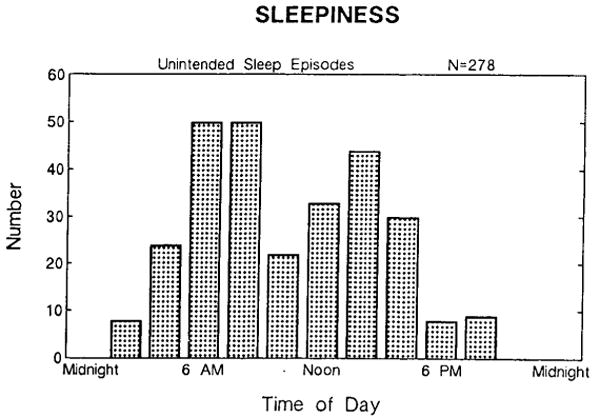
The number of unintentional sleep episodes observed at various times of day in the studies of Carskadon et al. (4–6). The pattern from noon to 8 p.m. has been widely replicated in studies using the Multiple Sleep Latency Test (7) and the Maintenance of Wakefulness Test (8).
Superimposed on the normal, two-peak pattern of sleep vulnerability are the effects of two separate but interacting factors: (a) sleep deprivation, such as that occurring during accommodation to an unusual work schedule (13), and (b) sleep disruption, such as that resulting from a sleep disorder (14). The effects of such sleep loss are cumulative. Thus, the danger of an error due to sudden overwhelming sleepiness increases progressively with continued sleep loss or “sleep debt.” Most individuals cope with significant sleep debt by physical activity and dietary stimulants. Coping mechanisms can temporarily make an individual completely unaware of a dangerous accumulated sleep loss. But when defenses are “let down,” as during a period requiring immobility, overwhelming sleepiness ensues. Such unawareness may account for seemingly incomprehensible instances in which individuals have permitted themselves to sleep in circumstances that cause great hazard for themselves and others. Thus, the more sleep is disturbed or reduced, for whatever reason, the more likely an individual will inadvertently slip into sleep. There is laboratory evidence to suggest that even brief episodes of sleep, called “microsleeps,” produce inattention, forgetfulness, and performance lapses, particularly during the two zones of vulnerability within the 24-h cycle (15).
The committee assessed the potential medical, industrial, and environmental significance of this physiologically based two-peak rhythm in human sleep tendency by evaluating the extent to which it is reflected in field studies documenting the temporal distribution of medical incidents, human error, and accidents. The primary rationale for making this assessment is the potentially catastrophic impact that time-dependent drops in human efficiency could have on a world that operates increasingly around-the-clock and where human accidents can endanger large segments of the population and the environment.
Mortality
Although it has been known for some time that spontaneous labor and birth are most likely to occur in the middle of the night (i.e., midnight to 6 a.m.), death has now also been shown to occur most often near the sleepiness zone. A major peak of deaths occurs between 4 and 6 a.m., and a smaller peak occurs between 2 and 4 p.m. Figure 2 presents a composite temporal distribution of human mortality based upon 50 studies and a total of more than 437,000 deaths due to all causes (16,17).
Fig. 2.
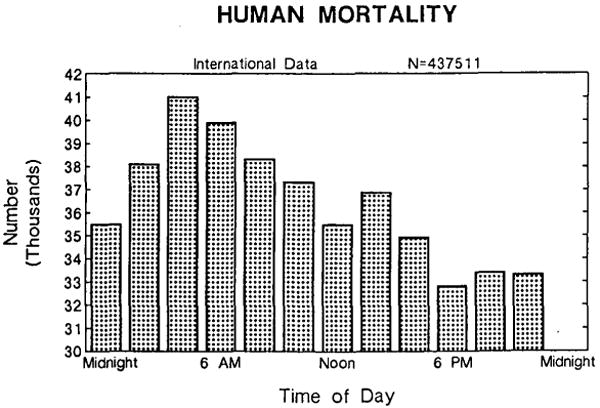
Number of human deaths per 2-h interval in the 437,511 deaths analyzed by Smolensky et al. (16) and Mitler et al. (17).
Heart attacks
Very recent work (18–21) assessing the timing of myocardial infarctions also reveals that the likelihood of suffering a heart attack varies significantly across time-of-day, with a peak between 6 and 10 a.m. Figure 3 displays the temporal distributions of the 4,666 cardiac deaths evaluated by Mitler et al. (19) and Muller et al. (21) as a function of time of day. Although reflecting the same bimodal pattern throughout the 24-h day as the sleep tendency and mortality data, these myocardial infarct peaks are shifted to a somewhat later time than those in the previous figures. The reasons for this shift are not clear. If sleep or sleep-related factors (e.g., prolonged immobility and horizontal position) do play a role in the increased incidence of infarcts at these times, their effect is pronounced soon after the usual sleep period of our population. Some of the time shift in the morning peak may stem from the fact that many people with heart disease adopt the practice of sleeping later in the morning. In any case, there is a clear 1 or 2-h phase delay in peak incidence of death due to infarct with respect to peak sleep tendency.
Fig. 3.
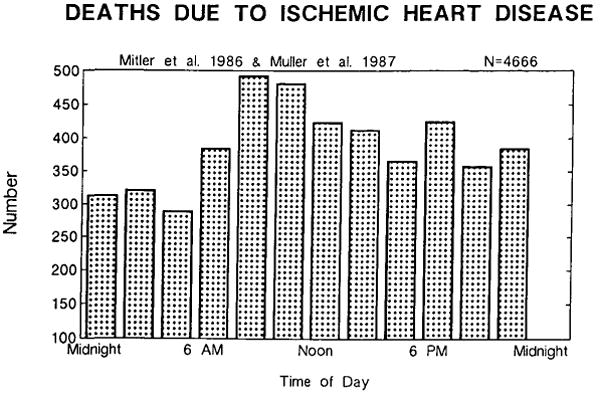
Number of human deaths attributed to ischemic heart disease per 2-h interval from the data of Mitler et al. (17) and Muller et al. (21).
The committee considered alternative explanations for the two-peak pattern, such as “discovery artifact” (i.e., the hypothesis that the peaks in heart attacks, and perhaps mortality as well, are due to greater chance of discovery after nearby survivors get up in the morning or come home from work in the afternoon). However, the same two-peak pattern has been observed in physiological monitoring studies of cardiac abnormalities that would not be subject to discovery artifact (22). Clearly, the shape of the temporal distribution in heart attacks is nonrandom and similar to that found for mortality and for human sleep-related functions. This pattern suggests that pathophysiological factors producing such a function may be related to the rhythmic processes underlying sleep and its timing.
Vehicular accidents
Several evaluations have been conducted on vehicular accidents throughout the 24-h day. Many factors can contribute to accidents, including road conditions, traffic congestion, and speed limits. Also, the total number of automobile and truck accidents is generally greater during the daytime (circa 10 a.m. to 6 p.m.) than at other times because of increased vehicle traffic during this time (23,24, and G. W. Duff, unpublished observations). Of special interest to the committee, however, was the temporal distribution of single-vehicle accidents (e.g., driving off the road), because we suspect that these accidents have a greater probability of being related to inadvertent lapses in driver attention. Studies of single-vehicle automobile accidents (23,24, and G. W. Duff, unpublished observations) reveal a bimodal temporal pattern. Figure 4 presents a composite temporal distribution of >6,000 single-vehicle traffic accidents attributed to “falling asleep at the wheel” taken from studies in Israel (23), Texas (24), and New York (G. W. Duff, unpublished observations). The major peak occurs between midnight and 7 a.m. and is especially pronounced between 1 and 4 a.m., while a small secondary peak is visible between 1 and 4 p.m. When the incidence among various age groups is examined, this secondary peak becomes more pronounced in drivers >45 years of age (24).
Fig. 4.
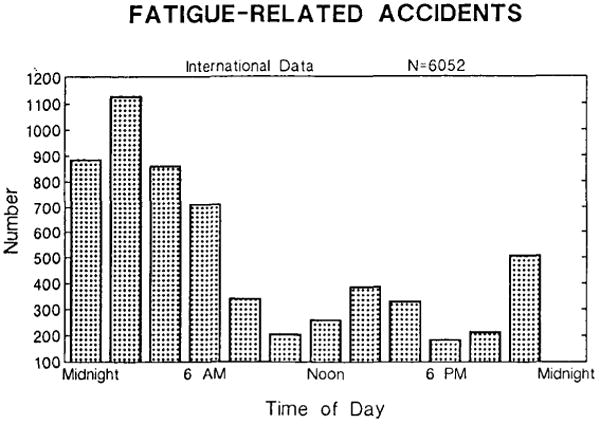
Temporal distribution of 6,052 vehicular accidents that were judged by investigators to be fatigue-related displayed as a function of time of day. The figure combines the samples of Lavie et al. (23) (Israel: n = 390), Langlois et al. (24) (Texas: n = 4,994) and Duff (unpublished observations) (New York: n = 668).
All other vehicle accident data available to the committee appeared to be consistent with the temporal distribution depicted in Fig. 4. Data on the time of day that German automobile drivers reported 569 instances of drowsiness while at the wheel also show peaks at these two times (25). An investigation of 742 public bus accidents between 5:30 and 12:30 a.m. in the Netherlands revealed the highest incidences of accidents occurred for drivers who began work early, between 5 and 6 a.m., with the next highest for those who began work between 1 and 2 p.m. (26,27).
The committee also evaluated data on the temporal distribution of single-vehicle truck accidents (28,29). A United States study of 493 such accidents revealed that the peak time of occurrence was between 1 a.m. and 7 a.m. (28). A recent extensive study of >13,700 truck accidents in the state of Washington (both single- and multi-vehicle) focused specifically on accidents involving transportation of hazardous materials (29). Although truck accidents in general were more likely to occur during the middle of the work day, the 130 serious accidents involving hazardous materials had a mode of occurrence between 6 and 9 a.m. and usually happened under good driving conditions on a straight road. The report concluded that driver inattention and carelessness appeared to play a greater role in truck accidents involving hazardous materials than did poor driving conditions or difficult maneuvers. It is not unreasonable to suggest that, given the similarity of the temporal pattern of vehicular accidents to the temporal pattern underlying sleep-related processes, the inattentiveness and carelessness that contributes significantly to the former has its basis in the latter.
Finally, a related study examined the temporal distribution throughout the day of >2,200 automatically induced emergency braking incidents, caused by errors of response omission made by locomotive drivers of the German Federal Railways. Although no accidents were involved, the data revealed two peaks, one between 3 and 6 a.m. and a second between 1 and 3 p.m. (30).
Performance errors
The committee also evaluated field studies reporting the temporal distribution of human errors other than those involving vehicular operation. The most extensive study conducted to date was carried out in a Swedish gas works and assessed the 24-h distribution of 75,000 meter-reading errors during a 20-year period (31). Figure 5 shows the familiar two-peak pattern of these errors: there is a major peak between 2 and 4 a.m. and a minor peak between 2 and 4 p.m. Other studies of human performance, errors, and accidents in work settings also reflect this bimodal pattern (32–35).
Fig. 5.
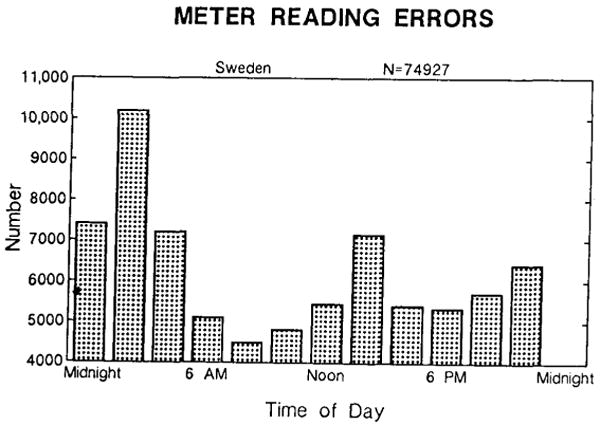
Temporal distribution of 75,000 meter-reading errors plotted in the same 2-h format as Figs. 1–4. Data are taken from Bjerner et al. (31).
Industrial and engineering disasters
Unfortunately, few data have been systematically gathered on the temporal distribution of major industrial and engineering accidents, particularly those that threaten public health and safety. As an alternative approach, the committee examined available information on the timing and nature of one of the most serious recent incidents in the commercial nuclear power industry and of the NASA space shuttle program.
The most serious United States incident in a commercial nuclear power plant occurred at 4 a.m. on March 28, 1979, at the Three Mile Island plant unit 2 reactor in Pennsylvania (36). Between the hours of 4 and 6 a.m., shiftworkers failed to recognize the loss of core coolant water resulting from a stuck valve. Although a mechanical problem precipitated the incident, it was chiefly this human error of omission and the subsequent flawed corrective action that caused the near meltdown of the reactor later that morning.
More recently, there have been two other serious incidents in the United States nuclear power industry that involved human errors committed during the early morning hours. On June 9, 1985, the Davis-Besse reactor at Oak Harbor, Ohio, went into automatic shutdown followed by a total loss of the main feedwater at 1:35 a.m. The incident became even more critical when an operator then pushed the wrong two buttons in the control room, thereby defeating the safety function of the auxiliary feed-water system (37). The subsequent combination of equipment malfunctions and human errors made the situation dangerous, but corrective action eventually stabilized the reactor. On December 26, 1985, the Rancho Seco nuclear reactor near Sacramento, California, automatically tripped after DC power to the integrated control system was lost at 4:14 a.m. For a variety of reasons, including equipment design flaws, inadequate training, and human errors of omission and commission, operators were slow to regain control of the plant (38). Perhaps most disturbing is the fact that the nuclear plant catastrophe at Chernobyl is officially acknowledged to have begun at 1:23 a.m. as the result of human error (39,40). The limited amount of information currently available about the human factors component of this accident, however, makes it difficult to draw any firm conclusions about the contribution of sleep-related errors in performance or judgment.
In contrast, the recent report of the Presidential Commission on the Space Shuttle Challenger Accident did cite the contribution of human error and poor judgement related to sleep loss and shiftwork during the early morning hours (41). In describing the substantial sleep loss experienced by senior managers at Marshall Space Flight Center before the evening teleconference with Morton-Thiokol on January 27, 1986, the report stated that the decision to launch “should have been based on engineering judgments. However, other factors may have impeded or prevented effective communication and exchange of information” (p. G-5). The effect on managers of irregular working hours and insufficient sleep “may have contributed significantly to the atmosphere of the teleconference at Marshall” (p. G-5). Certain key managers had obtained <2 h sleep the night before and had been on duty since 1:00 a.m. that morning. The report noted that “time pressure, particularly that caused by launch scrubs and turnarounds, increased the potential for sleep loss and judgment errors” and that working “excessive hours, while admirable, raises serious questions when it jeopardizes job performance, particularly when critical management decisions are at stake” (p. G-5).
A more typical early morning shiftwork error was also cited by the commission in its reporting of a previous near-catastrophic launch of the shuttle Columbia on January 6, 1986. Console operators at Kennedy Space Center inadvertently drained 18,000 pounds of liquid oxygen from the shuttle external tank within 5 min before scheduled launch. The liquid oxygen loss went undetected until after the mission was cancelled only 31 s before liftoff because of a secondary effect on the engine inlet temperature. Operator fatigue was reported “as one of the major factors contributing to this incident” (p. G-1). The operators had been on duty for 11 h. It was their 3rd day of working on a 12-h night shift. As is often the case in industrial accidents, the contribution of human error was precipitated by an unusual mechanical or control system malfunction. In this case, such a malfunction occurred during the final tanking procedure. The Commission concluded, “An evaluation by NASA of the consequences of work schedules should be conducted as part of its effort to reform its launch and operational procedures” (p. G-1).
Conclusions And Recommendations
It cannot be proved that the human responses and errors occurring in all or most of these incidents and accidents resulted from lowered alertness, inattention, or delayed reaction due to active, sleep-related processes. Yet, it appears to be more than coincidental that the serious accidents were made worse by inadequate human response at a time when other data reflect a diminished capacity to function effectively despite one's belief and best intentions. In the public and governmental debates that followed some of the most serious incidents, such as the Three Mile Island, Chernobyl, and Challenger disasters, the emphasis has consistently been placed on the extent to which technological failures and high-level policy decisions contributed to the catastrophes. While these factors are important, they do not abrogate the responsibility to attend to the less obvious factors affecting individual participants, who often are judged afterwards to have contributed significantly to the accident through human error. The consistent temporal pattern of physiologic events and performance-related incidents found by the committee suggests that such critical human errors have a basis in the brain mechanisms that control sleep and many other oscillatory processes underlying human physiology, behavior and judgment. Sleep and sleep-related factors appear to be involved in widely disparate types of disasters.
The committee makes the following recommendations:
The period from 1 to ∼8 a.m. constitutes a time span in the 24-h day when human medical and performance catastrophes are far more likely to occur. A secondary and less pronounced zone of vulnerability also occurs in the afternoon from 2 to roughly 6 p.m. Policy and regulatory agencies in both the public and private sectors should be more aware of the losses society has sustained as a function of diminished capacity during these zones of vulnerability. Increased awareness of these issues, including the fact that they affect all humans, will help prevent some of the more serious consequences of accidents and errors during these periods. The committee urges policy makers in the fields of organized labor, management, and government to consider relevant aspects of sleep physiology that affect performance.
Medical catastrophes, such as myocardial infarction and strokes, are more likely to occur at certain times of the day than at other times. Factors associated with increased risk of medical problems and mortality in the morning after a night's sleep should be further elucidated to more efficiently direct health care resources toward identifying patient populations at risk for such catastrophes and preventing unnecessary morbidity and mortality.
Programs should be developed to identify the signs of sleep-related error in vehicle operation and on the job, particularly in industries that have a responsibility to minimize accident and error for the sake of public health and safety (e.g., transportation of hazardous materials, nuclear plants).
The committee recognizes that inadequate sleep, even as little as 1 or 2 h less than usual sleep, can greatly exaggerate the tendency for error during the time zones of vulnerability. Moreover, sleep loss combined with a period of stress, such as is faced by working groups before production deadlines or launch deadlines, can lead to personality change and irrational behavior. The committee therefore recommends that industries and services affecting public safety should address the physiological needs of the workers and the safety requirements of society at large. Management should also limit active duty hours for all personnel to assure that adequate time for sleep is obtained between successive periods on duty. These limitations should apply to white-collar and/or decision-making personnel, as well as equipment operators. Such steps must also be coupled with educational programs for workers to foster the physiologically sound use of scheduled rest time.
Attention should be given to the identification of the least adaptive shiftwork schedules and to the implementation of schedules that promote health and safety at minimal expense. The schedules of decision makers and the workload of key personnel should minimize the influence the biological sleep tendencies that increase the likelihood of human error.
Laboratory and field research is needed to determine the processes that produce the bimodal temporal pattern in so many facets of human function. Identification of the mechanisms involved will facilitate efforts toward developing effective countermeasures to minimize the often catastrophic consequences of sleep-related brain processes. Such countermeasures will be essential if society is to continue its relentless push to around-the-clock operations in all aspects of life both on the planet and as we broach the frontiers of space.
References
- 1.Association of Sleep Disorders Centers. Diagnostic classification of sleep and arousal disorders (1st ed. prepared by the Sleep Disorders Classification Committee, HP Roffwarg, Chair) Sleep. 1979;2:1–137. [PubMed] [Google Scholar]
- 2.Moore-Ede MC, Sulzman FM, Fuller CA. The clocks that time us. Cambridge, MA: Harvard University Press; 1982. [Google Scholar]
- 3.Lamberg Lynne. The American Medical Association. Guide to better sleep. New York: Random House; 1984. [Google Scholar]
- 4.Carskadon MA, Littell WP, Dement WC. Sleep Res. Vol. 14. 1985. Constant routine: alertness, oral body temperature, and performance; p. 293. [Google Scholar]; Carskadon MA. Issues in daytime sleepiness. Invited presentation, Annual Meeting of The Association of Professional Sleep Societies; June 18, 1986; Columbus, Ohio. June 15–20, 1986. [Google Scholar]
- 5.Dement WC, Carskadon MA. An essay on sleepiness. In: Baldy-Moulinier M, editor. Actualites en medicine experimentale: en homage au professeur P Passouant. Montpelier: Euromed; 1982. pp. 47–71. [Google Scholar]
- 6.Richardson GS, Carskadon MA, Orav EJ, Dement WC. Circadian variation of sleep tendency in elderly and young adult subjects. Sleep. 1982;5:s82–92. doi: 10.1093/sleep/5.s2.s82. [DOI] [PubMed] [Google Scholar]
- 7.Richardson GS, Carskadon MA, Flagg W, van den Hoed J, Dement WC, Mitler MM. Excessive daytime sleepiness in man: multiple sleep latency measurement in narcoleptic and control subjects. EEG Clin Neurophysiol. 1978;45:621–7. doi: 10.1016/0013-4694(78)90162-1. [DOI] [PMC free article] [PubMed] [Google Scholar]
- 8.Mitler MM, Gujavarty KS, Browman CP. Maintenance of wakefulness test: a polysomnographic technique for evaluating treatment in patients with excessive somnolence. EEG Clin Neurophysiol. 1982;53:658–61. doi: 10.1016/0013-4694(82)90142-0. [DOI] [PMC free article] [PubMed] [Google Scholar]
- 9.Broughton R. Biorhythmic variations in consciousness and psychological functions. Can Psychol Rev. 1975;16:217–39. [Google Scholar]
- 10.Lavie P, Scherson A. Ultrashort sleep-waking schedule. I. Evidence of ultradian rhythmicity in “sleep-ability”. EEG Clin Neurophysiol. 1981;52:163–74. doi: 10.1016/0013-4694(81)90164-4. [DOI] [PubMed] [Google Scholar]
- 11.Gagnon P, De Koninck J, Broughton R. Reappearance of electroencephalogram slow waves in extended sleep with delayed bedtime. Sleep. 1985;8:118–28. doi: 10.1093/sleep/8.2.118. [DOI] [PubMed] [Google Scholar]
- 12.Dinges DF, Orne MT, Orne EC, Evans FJ. Voluntary self-control of sleep to facilitate quasi-continuous performance (U.S. Army Medical Research and Development Command Report No. 80.) Fort Detrick, Frederick, MD: U.S. Army Medical Research and Development Command; 1980. (NTIS No. AD-A102264) [Google Scholar]
- 13.Carskadon MA, Dement WC. Cumulative effects of sleep restriction on daytime sleepiness. Psychophysiology. 1981;18:107–13. doi: 10.1111/j.1469-8986.1981.tb02921.x. [DOI] [PubMed] [Google Scholar]
- 14.Carskadon MA, Brown ED, Dement WC. Sleep fragmentation in the elderly: relation to daytime sleep tendency. Neurobiol Aging. 1982;3:321–7. doi: 10.1016/0197-4580(82)90020-3. [DOI] [PubMed] [Google Scholar]
- 15.Dinges DF. The nature of sleepiness: causes, contexts and consequences. In: Baum A, Stunkard A, editors. Perspectives in behavioral medicine. New Jersey: Erlbaum; 1988. [Google Scholar]
- 16.Smolensky M, Halberg F, Sargent F. Chronobiology of the life sequence. In: Ito S, Ogata K, Yoshimura H, editors. Advances in climatic physiology. Tokyo: Igaku Shoin; 1972. pp. 515–6. [Google Scholar]
- 17.Mitler MM, Hajdukovic RM, Shafor R, Hahn PM, Kripke DF. When people die: cause of death versus time of death. Am J Med. 1987;82:266–74. doi: 10.1016/0002-9343(87)90067-2. [DOI] [PMC free article] [PubMed] [Google Scholar]
- 18.Muller JE, Stone PH, Turi ZG, et al. Circadian variation in the frequency of onset of acute myocardial infarction. N Engl J Med. 1985;313:1315–22. doi: 10.1056/NEJM198511213132103. [DOI] [PubMed] [Google Scholar]
- 19.Mitler MM, Kripke DF. Circadian variation in myocardial infarction. N Engl J Med. 1986;314:1187–8. doi: 10.1056/NEJM198605013141811. [DOI] [PubMed] [Google Scholar]
- 20.Kolata G. Heart attacks at 9:00 a.m. Science. 1986;233:417–8. doi: 10.1126/science.3726536. [DOI] [PubMed] [Google Scholar]
- 21.Muller JE, Ludmer PL, Willich SN, et al. Circadian variation in the frequency of sudden cardiac death. Circulation. 1987;75:131–8. doi: 10.1161/01.cir.75.1.131. [DOI] [PubMed] [Google Scholar]
- 22.Araki H, Koiwaya Y, Nakagaki O, Nakamura M. Diurnal distribution of ST-segment elevation and related arrhythmias in patients with variant angina: a study of ambulatory ECG monitoring. Circulation. 1983;67:995–1000. doi: 10.1161/01.cir.67.5.995. [DOI] [PubMed] [Google Scholar]
- 23.Lavie P, Wollman M, Pollack I. Frequency of sleep related traffic accidents and hour of the day. Sleep Res. 1986;15:275. [Google Scholar]
- 24.Langlois PH, Smolensky MH, Hsi BP, Weir FW. Temporal patterns of reported single-vehicle car and truck accidents in Texas, U.S.A., during 1980–1983. Chronobiology Int. 1985;2:131–40. doi: 10.3109/07420528509055552. [DOI] [PubMed] [Google Scholar]
- 25.Prokop O, Prokop L. Ermudung und einschlafen am steuer. [Fatigue and falling asleep while driving]. Dtsch Z Gerichtl Med. 1955;44:343–55. [PubMed] [Google Scholar]
- 26.Pokorny MLI, Blom DHJ, van Leewen P. Analysis of traffic accident data (from busdrivers)—an alternative approach (I) In: Reinberg A, Vieux N, Andlauer P, editors. Night and shift work: biological and social aspects. New York: Pergamon Press; 1981. [Google Scholar]
- 27.Pokorny MLI, Blom DHJ, van Leewen P. Analysis of traffic accident data (from busdrivers)—an alternative approach (II) In: Reinberg A, Vieux N, Andlauer P, editors. Night and shift work: biological and social aspects. New York: Pergamon Press; 1981. [Google Scholar]
- 28.Mackie RR, Miller JC. Effects of hours of service, regularity of schedules, and cargo loading on truck and bus driver fatigue (Human Factors Research, Inc. Technical Report No. 1765-F.) Washington, DC: Department of Transportation. Bureau of Motor Carrier Safety, FHWA, and National Highway Traffic Safety Administration; 1978. [Google Scholar]
- 29.Richards A. Analysis of accidents involving hazardous materials in Washington State (Research Project). May 5, 1986 (contact Dr. Abkowitz, Washington State University). Data discussed by Abelson PH. Science. 1986;234:125. [Google Scholar]
- 30.Hildebrandt G, Rehmert W, Rutenfranz J. Twelve- and 24-h rhythms in error frequency of locomotive drivers and the influence of tiredness. Int J Chronobiol. 1974;2:175–80. [PubMed] [Google Scholar]
- 31.Bjerner B, Holm A, Swensson A. Diurnal variation in mental performance: a study of three-shift workers. Br J Ind Med. 1955;12:103–10. doi: 10.1136/oem.12.2.103. [DOI] [PMC free article] [PubMed] [Google Scholar]
- 32.Browne RC. The day and night performance of teleprinter switchboard operators. Occup Psychol. 1949;23:121–6. [Google Scholar]
- 33.Wojtczak-Jaroszowa J, Pawlowska-Skyba K. Praca nocna i zmianowa: I. Dobowe wahania sprawnosci a wydajnosc pracy [Work at night and shiftwork: I. Day and night oscillations of working capacity and the work efficiency] Med Pr. 1967;18:1–10. [PubMed] [Google Scholar]
- 34.Folkard S, Monk TH, Lobban MC. Short and long-term adjustment of circadian rhythms in “permanent” night nurses. Ergonomics. 1978;21:785–99. doi: 10.1080/00140137808931782. [DOI] [PubMed] [Google Scholar]
- 35.Graeber RC, Foushee HC, Gander PH, Noga GW. Circadian rhythmicity and fatigue in flight operations. J UOEH. 1985;7(suppl):122–9. [PubMed] [Google Scholar]
- 36.U.S. Nuclear Regulatory Commission. Investigation into the March 28, 1979 Three Mile Island Accident by the Office of Inspection and Enforcement (Investment Report No. 50-320/j79-10). July, 1979, NTIS NUREG-0600
- 37.U.S. Nuclear Regulatory Commission. Loss of main and auxiliary feedwater event at the Davis-Besse Plant on June 9, 1985 (Investigative Report). July, 1985, NTIS NUREG-1154. See also New York Times December 17, 1985. “U.S. Announces $900,000 Fine in Accident at Ohio Nuclear Plant.”
- 38.U.S. Nuclear Regulatory Commission. Loss of integrated control system power and overcooling transient at Ranch Seco on December 26, 1985 (Investigative Report). February, 1986, NTIS NUREG-1195. See also Science, January 24, 1986. “Rancho Seco Reactor Suffers Another Mishap.”
- 39.International Nuclear Safety Advisory Group. Summary report on the post accident review meeting on the Chernobyl accident (25–29 August, 1986; Vienna, Austria). International Atomic Energy Agency, November 1986. ISBN #92-0-123186-5
- 40.U.S. Nuclear Regulatory Commission. Report on the accident at the Chernobyl nuclear power station. January, 1987, NTIS NUREG 1250.
- 41.Report of the Presidential Commission on the Space Shuttle Challenger Accident. II. Washington, DC: U.S. Government Printing Office; 1986. Appendix G. [Google Scholar]


